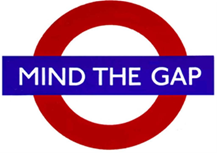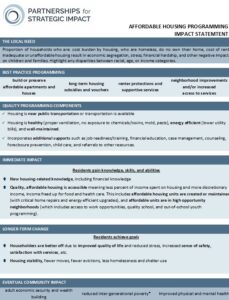November 2021
By Maryfrances Porter & Alison Nagel
There’s a formula for telling a masterful impact story, one that captures the attention of funders and moves people to action. It all starts with being able to talk about programming that works. Here’s how to do it…
Stop Starting at the End
When most people think about impact storytelling, they immediately think about the impact they are making – and why wouldn’t they?!? It’s a story about impact, right?!?

Well – actually – impact storytelling has to start with talking about why your programming is expected to make a difference in people’s lives. When you think about it, this is really just like telling any great story. Stand By Me is a quintessential coming of age story: when Rob Reiner told this story in the mid-80’s, he didn’t start with . . . . . . . (spoiler alert!). . . . . . . the boys banding together in newfound solidarity to stand up to bullies (“No, Ace, just you.”) and do what’s right. No way! He started off introducing us to why we should care about a bunch of 12-year-old boys so we could be rooting for them as their adventure and relationship unfolded. This is the art of storytelling – even for nonprofit impact storytelling. Start at the beginning and set the stage, help your reader understand why what you do is important. Now, people know what impact to root for!
Start with Programming that Works
We talk a lot about how nonprofits are practitioners, not scientists – which means that their job is to (a) deliver programs that have been proven to work and (b) make sure the people they work with get better. (Scientists, on the other hand, do the research that develops and tests whether programs work; this research costs a lot of money and takes a long time.)
When you start your impact story by talking about why the programming you’re using is expected to work, well, you’re letting your reader know why they should be invested in what you’re doing. You’re saying: “there’s a problem in our community and our nonprofit knows how to address it. Here’s how… And… here’s what you should be rooting for!”
Focusing on programming that works also allows you do the following half-dozen things:
First: You can rest easy knowing that your organization isn’t just doing something that feels good, but you’re doing something that also results in good. This is a nice place to start.
Second: Using programming that has already been shown to work really focuses your organization by centering on the impacts the programming has already been shown to create. It can be easy to get lost in all the different ways you do good, and this can help you streamline your message. Clarity.
Third: If you are using programming that has been proven to have long-term impacts, it frees you up to show how your clients get the program’s short-term impacts (e.g., make sure they leave your office with something valuable) and, why they are therefore expected to go on to make long-term change in their lives. You no longer have to carry the burden of demonstrating your clients actually make long-term change. Doesn’t that feel better!?!
Fourth: You are freed from having to have a comparison group of people who did not get programming. We won’t go into all the scientific reasons for comparison groups, or the different types, or methodological or ethical pros and cons. What we will say is that your mission is to serve as many people as possible – not to follow people who don’t get intervention or to randomly withhold intervention. Just go out and do your good work. Reach as many people as possible.
Fifth: You’re positioning yourself as the expert – just like the doctor. If you can talk about why programming works, then you are able to be clear and confident when talking to funders about the efficacy of what you’re doing. You can talk about this convincingly before you have served a single person!
Sixth: Yes! There’s more! When you’re clear and confident and informed, you are trusted. When people trust you, they invest: they invest their money, their time, their advocacy, and they actually trust you enough to put their lives in your hands.
What if You Need Something New?
There are way more problems in the world than there are out-of-the-box, evidence-based programs. So, what do you do if (1) the evidence-based program needs to be adapted to fit your population or community conditions, (2) you “know” that what you do is based in science, but you just don’t have the articles in your hand and you’re really just not sure how to write about it, or (3) there really isn’t nicely packaged science that demonstrates that what you do works, but you’re pretty sure if you had the time to scour the internet you could come up with something. Other times there really isn’t research to support what your program is doing but the practice is considered the State-of-the-Art or a Best Practice. Luckily, there’s usually ways of supporting that too. Maybe you’re doing something entirely new and untested; that’s wonderful! Way to innovate! Now, let’s figure out how to talk about why what you’re doing is probably a good idea.
Customizing evidence-based practices or pulling together the disparate science and data can be tricky! This is actually one of the times that we really recommend bringing in an experienced consultant. You need someone with the expertise to efficiently do the research and pull it together succinctly much more quickly than you can yourself.
We Mind the Gap

We have noticed is that there’s a pretty big gap between the existence of an evidence-based program and a nonprofit being able to find it – or – bigger gap – talk about it! That’s where we come in. Since we have been scientists and practitioners, we really understand this gap. We have lived in it for decades, and it can be a confusing and overwhelming place. But with patience and perseverance we have learned how to navigate and bridge it for you! Here are three ways we can help.
Our Solution #1: Our Resource Library
Hop on over to our Resource Library and click on the tag: Programming that Works. Here we have compiled all the most common (and many less common) databases and publications on programs that work in the realm of human services. Each of these resources has been hand picked for small- and medium-sized nonprofits. You won’t find any hard-to-read scientific papers here. Just down-to-earth real information, all annotated to help you get what you need quickly.
Our Solution #2: Our Ready-Made Impact Statements

We have created Impact Statements that are captivating to funders (we know because a funder was the first person to ask us for one)! These are lovely little two-page summaries of what works in different areas. You can get the Impact Statement for Affordable Housing here for free (How To Read guide included)! You can also purchase Impact Statements for Workforce Development, Early Childcare and Education, K-12 Education, Home Visiting, and Out-of-School Time in our ImpactStore.
Our Solution #3: Custom Impact Statements
We are working with our brilliant colleagues at Madison House to develop a custom Impact Statement for Service Learning, and we can create one for you too! Just go to the ImpactStore and purchase a Custom Impact Statement for your organization. Be sure to talk to us first so we can be sure we are creating exactly what you need!
ImpactStory™ Coaching
 At Partnerships for Strategic Impact®, we focus on coaching, training, and supporting small- and medium-sized nonprofits in telling powerful impact stories.
At Partnerships for Strategic Impact®, we focus on coaching, training, and supporting small- and medium-sized nonprofits in telling powerful impact stories.
We are the seasoned program-development-evaluation-data-storytelling consultant you need, right in your back pocket. We are here to bring order to the overwhelm of figuring out how to capture and use your impact to move people to action.
This is within reach. Your funders and the people being served deserve to know more about the value your organization delivers.
We Get It
Your work is value driven. Its value lies in the impact of your work on the people served. Let us help you tell your impact story. Reach out, answering questions is our specialty.
— Maryfrances & Alison
ImpactStory™ Coaches
Want more? Check out our Blogs and Videos.
We also curate and annotate resources just for small- and medium-sized nonprofits. Check out our Resource Library.
Looking for excellent consultants to help you with your next project? Search (or contribute to!) our growing directory of Recommended Consultants – recommended by and for small- and medium- sized nonprofits.


